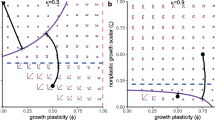Abstract
In this paper, we propose a theoretical framework within which a unified treatment of the key sources of size-at-age variability—size dependence of growth rate, stochastic growth rate variations and individual-to-individual variability in growth performance—is possible. We use this framework to develop a general criterion for growth depensation in cohorts, which we define as the increase of the coefficient of variation of size-at-age, with increasing age. We use this criterion to show that size dependence of growth rate, acting alone, is depensatory only if the growth rate increases faster than linearly with size (that is, if growth is faster than exponential), while stochastic growth rate variation is invariably depensatory. Many species exhibit growth rates that scale less than linearly with size; indeed the commonly used von Bertalanffy model shows growth rates which actually decrease with size. In such a species, the size dependence of growth rate acts compensatorily, while stochastic growth rate variability is depensatory. We show that the tension between these two mechanisms leads to quasi-stationary size-at-age variability, which we can calculate analytically in some special cases and obtain by a simple numerical procedure where analysis is impractical.
Similar content being viewed by others
References
Bardos, D.C., 2005. Probabilistic Gompertz model of irreversible growth. Bull. Math. Biol. 67, 529–545.
Brunkow, P.E., Collins, J.P., 1998. Group size structure affects patterns of aggression in larval salamanders. Behav. Ecol. 9, 508–514.
DeAngelis, D.L., Huston, M.A., 1987. Effects of growth rates in models of size distribution formation in plants and animals. Ecol. Modell. 36, 119–137.
DeAngelis, D.L., Cox, D.C., Coutant, C.C., 1979. Cannibalism and size dispersal in young of the year large-mouth bass: Experiments and model. Ecol. Modell. 24, 21–41.
de Roos, A.M., Diekmann, O., Metz, J.A.J., 1992. Studying the dynamics of structured population models: A versatile technique and its application to Daphnia population dynamics. Am. Nat. 139, 123–147.
Fujiwara, M., Kendall, B.E., Nisbet, R.M., 2005. Growth autocorrelation and animal size variation. Ecol. Lett. 7, 106–113.
Fujiwara, M., Kendall, B.E., Nisbet, R.M., Bennett, W.A., 2005. Analysis of size trajectory data using an energetic-based growth model. Ecology 86, 1441–1451.
Gompertz, B., 1825. On the nature of the function expressive of the law of human mortality, and on a new mode of determining the value of life contingencies. Philos. Trans. R. Soc. Lond. 115, 513–585.
Imsland, A.K., Nilsen, T., Folkvord, A., 1998. Stochastic simulation of size variation in Turbot: Possible causes analysed with an individual-based model. J. Fish. Biol. 53, 237–258.
Marteinsdottir, G., Begg, G., 2002. Essential relationships incorporating influences of age, size and condition on variables required for estimation of reproductive potential in Atlantic cod (Gadus morhus) stocks. Mar. Ecol. Prog. Ser. 235, 235–256.
Nisbet, R.M., Gurney, W.S.C., 2003. Modelling Fluctuating Populations. Blackburn, Caldwell, NJ, pp. 243–250.
Pfister, C.A., Stevens, F.R., 2002. The genesis of size variability in plants and animals. Ecology 83, 59–72.
Pfister, C.A., Peacor, S.D., 2003. Variable performance of individuals: The role of population density and endogenously formed landscape heterogeneity. J. Anim. Ecol. 72, 725–735.
Ricker, W.E., 1958. Handbook of Computations for Biological Statistics of Fish Populations. Fisheries Research Board of Canada, Nanaimo, BC, Canada. Bulletin 119.
Rose, G., 2004. Reconciling overfishing and climate changes with stock dynamics of Atlantic cod (Gadus morhua) over 500 years. Can. J. Fish. Aquat. Sci. 61, 1553–1557.
Sebens, K.P., 1987. The ecology of indeterminate growth. Ann. Rev. Ecol. Syst. 18, 371–407.
von Bertalanffy, L., 1938. A quantitative theory of organic growth (inquiries on growth laws) II. Hum. Biol. 10, 181–213.
von Foerster, H., 1959. Some remarks on changing populations. In: Stohlman, F. (Ed.), The Kinetics of Cellular Proliferation. Grune and Stratton, New York.
Wootton, J.T. 1992. Indirect effects, prey susceptibility and habitat selection: Impacts of birds on limpets and algae. Ecology 73, 981–991.
Author information
Authors and Affiliations
Corresponding author
Rights and permissions
About this article
Cite this article
Gurney, W.S.C., Veitch, A.R. The Dynamics of Size-at-Age Variability. Bull. Math. Biol. 69, 861–885 (2007). https://doi.org/10.1007/s11538-006-9167-8
Received:
Accepted:
Published:
Issue Date:
DOI: https://doi.org/10.1007/s11538-006-9167-8




